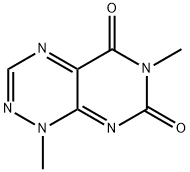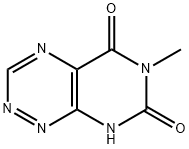Toxoflavin
Synonym(s):1,6-Dimethyl-pyrimido[5,4-e]-1,2,4-triazine-5,7(1H,6H)-dione;Toxoflavin;Xanthothricin
- CAS NO.:84-82-2
- Empirical Formula: C7H7N5O2
- Molecular Weight: 193.16
- MDL number: MFCD00459812
- SAFETY DATA SHEET (SDS)
- Update Date: 2023-09-04 15:51:00

What is Toxoflavin?
The Uses of Toxoflavin
Toxoflavin is a distinctive yellow pigment produced by some species of Pseudomonas and Streptomyces. Toxoflavin is one of two toxins produced when a fermented coconut drink, Tempe bonkrek, is contaminated with P. cocovenenans. Toxoflavin (PKF 118-310) is a potent antagonist of Tcf4/b-catenin signalling, inhibiting the expression of survivin and inducing apoptosis in several tumour cell lines.
The Uses of Toxoflavin
PKF118-310 is an inhibitor of survivin expression and antagonist of Tcf4/b-catenin signaling.
What are the applications of Application
PKF118-310 is an inhibitor of survivin expression and antagonist of Tcf4/b-catenin signaling
Definition
ChEBI: Toxoflavin is a pyrimidotriazine that is 1,6-dimethyl-1,5,6,7-tetrahydropyrimido[5,4-e][1,2,4]triazine with oxo groups at positions 5 and 7. It has a role as an antineoplastic agent, a toxin, a Wnt signalling inhibitor, an apoptosis inducer, a bacterial metabolite, an antibacterial agent and a virulence factor. It is a pyrimidotriazine and a carbonyl compound. It is functionally related to a reumycin.
Biochem/physiol Actions
PKF118-310 is an antagonist of the Tcf4/b-catenin signaling. The compound disrupts the Tcf4/b-catenin complex and inhibits expression of Tcf4 responsive genes. PKF118-310 inhibits expression of survivin and induces apoptosis in HCC, colon tumor and lymphocytic leukemia cell lines.
Properties of Toxoflavin
| Melting point: | 165 °C |
| Boiling point: | 276.7±23.0 °C(Predicted) |
| Density | 1.65±0.1 g/cm3(Predicted) |
| storage temp. | 2-8°C |
| solubility | H2O: soluble10mg/mL, clear |
| form | powder |
| pka | -2.71±0.20(Predicted) |
| color | white to light brown |
Safety information for Toxoflavin
| Signal word | Danger |
| Pictogram(s) |
 Skull and Crossbones Acute Toxicity GHS06 |
| GHS Hazard Statements |
H300:Acute toxicity,oral |
| Precautionary Statement Codes |
P264:Wash hands thoroughly after handling. P264:Wash skin thouroughly after handling. P270:Do not eat, drink or smoke when using this product. P301+P310:IF SWALLOWED: Immediately call a POISON CENTER or doctor/physician. P405:Store locked up. P501:Dispose of contents/container to..… |
Computed Descriptors for Toxoflavin
New Products
4-(Dimethylamino)tetrahydro-2H-pyran-4-carbonitrile 4-AMINO-TETRAHYDRO-PYRAN-4-CARBOXYLIC ACID 4-Aminotetrahydropyran-4-carbonitrile Hydrochloride (R)-3-Aminobutanenitrile Hydrochloride 4-AMINO-TETRAHYDRO-PYRAN-4-CARBOXYLIC ACID HCL 3-((Dimethylamino)methyl)-5-methylhexan-2-one oxalate 5-Bromo-2-nitropyridine Nimesulide BP Aceclofenac IP/BP/EP Diclofenac Sodium IP/BP/EP/USP Mefenamic Acid IP/BP/EP/USP Ornidazole IP Diclofenac Potassium SODIUM AAS SOLUTION ZINC AAS SOLUTION BUFFER SOLUTION PH 10.0(BORATE) GOOCH CRUCIBLE SINTERED AQUANIL 5 BERYLLIUM AAS SOLUTION Methylcobalamin (vitamin B12) SODIUM METHYL PARABEN SODIUM VALPROATE AMOXICILLIN (AMOXYCILLIN) TRIHYDRATE ACICLOVIRRelated products of tetrahydrofuran
You may like
-
 PKF118-310 CAS 84-82-2View Details
PKF118-310 CAS 84-82-2View Details
84-82-2 -
 1-Methyl-6-oxo-1,6-dihydropyridazine-3-carbonitrile 98%View Details
1-Methyl-6-oxo-1,6-dihydropyridazine-3-carbonitrile 98%View Details
99903-60-3 -
 88491-46-7 98%View Details
88491-46-7 98%View Details
88491-46-7 -
 1823368-42-8 98%View Details
1823368-42-8 98%View Details
1823368-42-8 -
 2-(3-(tert-butyl)phenoxy)-2-methylpropanoic acid 1307449-08-6 98%View Details
2-(3-(tert-butyl)phenoxy)-2-methylpropanoic acid 1307449-08-6 98%View Details
1307449-08-6 -
 Ethyl 3-(furan-2-yl)-3-hydroxypropanoate 25408-95-1 98%View Details
Ethyl 3-(furan-2-yl)-3-hydroxypropanoate 25408-95-1 98%View Details
25408-95-1 -
 2-Chloro-5-fluoro-1-methoxy-3-methylbenzene 98%View Details
2-Chloro-5-fluoro-1-methoxy-3-methylbenzene 98%View Details
1805639-70-6 -
 1784294-80-9 98%View Details
1784294-80-9 98%View Details
1784294-80-9

